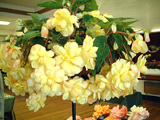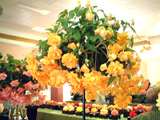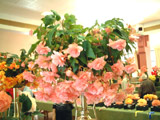| Home |
| About the Society |
| News |
| Growing |
| Pictures |
| Links |
| Contact Us |
| Sign The Guestbook |
The Cultivation of Pendula Begonias By Bert Weir
Pendula Begonias have long been favourites of the gardening public, and with justification. A Pendula begonia on display at a flower show, bearing a profusion of flowers is a sight that always causes great admiration, and gives the grower much satisfaction. They are grown mainly in hanging baskets where their pendulous habit can be displayed to great effect, but can equally be grown in the modern containers now available.
| Although the culture of pendulous begonias generally follows that of the large flowered hybrids, there are certain key differences that if followed will ensure a specimen plant fit for the show bench. The key areas of difference are as follows. |
- If the plant is to achieve its full potential it is desirable to start the tubers into growth approximately one month before the normal starting date for the large flowered varieties. Provided a propagator is available an ideal starting time is mid February. If you do not have a propagator, a later start will still produce a satisfactory plant, but remember the aim is to produce an exhibition quality plant at its peak for the August shows.
- Whereas the number of shoots produced on the large flowered hybrids is generally restricted to only one, on the Pendula tuber all shoots produced should be allowed to develop. Consequently take the minimum number of basal cuttings necessary to maintain your stock.
- To enhance the beauty of the plant during the flowering period, both male and female flowers are left on, as it is the mass of flowers that is important, not the size or form of an individual flower.
- The principal objective is to develop as many stems, and consequently, as many flowers as possible since it is the weight of flowers produced that pulls the stems over the side of the container to produce the pendulous effect.
| How many tubers per pot ? Carefully check the show schedule and stick to the number where specified. In practice the size of the tuber in relation to the size of the container determines the number. An ideal arrangement with tubers of one to two inches is to grow three plants in a ten to twelve inch container. If you have a large tuber of four inches then one to a container of the same size should suffice. Bear in mind that pendulas tend to be very vigorous and require plenty room. |
The growth should now be fairly rapid and when the stems are approx. six inches long the first flower buds will start to appear and at this stage all stems are cut back to below a leaf joint showing an eye. All the eyes below the cut will now grow on and there will be three or four shoots where only one existed before. The plant will now look pretty sorry but it will quickly recover and the new side shoots develop at a fairly rapid rate. When the side shoots show buds, nip out the growing point again, this will induce a further lot of side shoots, that are the ones to produce flowers. For a specific date allow 5/6 weeks for three quarter inch buds to reach full flower.
| Pendulas, when in full bloom tend to be fairly gross feeders, so commence feeding after the stems are cut back using a high potash fertiliser of your choice. Two popular types being Phostrogen or Maxicrop but any fertiliser with high potash content will be equally satisfactory. Feeding twice at half strength is much wiser than once at full strength. |
Watering is one area with which many growers find difficulty. It is one of the most important and difficult operations with any plant, in particular the begonia. The best advice is to give the plant a good watering from the top and refrain from further watering until it becomes dry again. Plants with weak root systems are particularly vulnerable, remember most plants can be ruined by overwatering.
Do not be tempted to take short cuts during the growing period as any attempt to do so will be reflected in the final quality of your plant. The advice given has been well tried and tested, and if followed will produce a plant that will give great satisfaction and hopefully make all the effort worthwhile.
A final word of caution, plants grown by this method can be up to three feet in diameter, and two feet deep, so for those wishing to show make sure they can be moved without damage.


